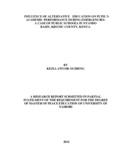| dc.description.abstract | According to Millennium Development Goals (MDGs) and Education For All (EFA„s)
objective for the year 2015 it is necessary to reinforce Education In Emergencies (EIE is
important for it offers preparedness, response and recovery of victims during disaster.
The study sought to answer the Ho hypothesis that there is no difference in offering
alternative physical environment during emergencies and pupils‟ performance. This study
sought to stress on the importance of combating environmental related conflicts by
proposing sound management of floods in Nyando Basin. Just as is like the feeling of UN
Peace building Commission, it is important to avail chance to address environmental
risks and provide a more consistent and coherent way of capitalizing on potential
opportunities. The study sought to express that managing floods is no longer an option
but a security imperative. The study highlight several educational ways of ensuring that
sustainable peace is obtained through flood management. These factors identified are,
alternative physical learning environment, alternative learning programs, teaching
strategies, support services and therapeutic program. The mechanisms mentioned would
go a long way in ensuring that performance is enhanced thus pointing out to a culture of
peace. The purpose of the study was to assess the influence of alternative educational
program on pupils‟ performance and its long run impact on the state of peace in the basin
region In the study, the researcher employed descriptive research design. The target
population for the study was respondents from public primary schools in Nyando Basin
Ombeyi Zone. The proportion of the target population was unavailable so 384 size
following Fisher et al‟s recommendation in Mugenda and Mugenda (2003) was used. The
sample size of the study was 384 respondents. This study planned to use questionnaires to
collect data from 1 TAC tutor,19 Head teachers, 38 class five to seven class teachers and
323 class six to eight pupils all from the 19 schools of study. Interviews were to be done
among 3 class eight class teachers from the schools in the sample, however only 309
pupils responded while from the other groups all response were retrieved.. Quantitative
and qualitative data were collected by using the mentioned tools that were later analyzed
by the use of descriptive statistics using the Statistical Package for Social Sciences
(SPSS) and presented by using both statistical and graphical techniques. The findings
were that when physical learning environment is offered during floods there tends to be
an influence in performance. The study therefore recommended that the meteorological
Department needs to be a little bit keener in forecasting early warning of floods, the
school stake holders should strive be fore hand and to ensure that schools physical
learning environment is safe for the pupils. | en_US |

